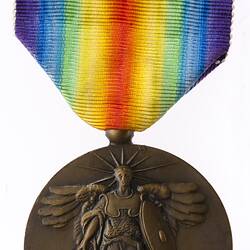Summary
Victory Medal 1914-1918, unnamed as issued, in the United States of America, 1918.
This was the only campaign medal issued by the United States of America, taking the form of the medal common to all of the victorious allied nations. Legislation in the United States was implemented by the Army in War Department General Orders Number 48 of April 9, 1919 (which was replaced by War Department General Orders Number 83 of June 30, 1919). It was implemented for the Navy by Navy Department General Orders Number 482 of July 30, 1919. The medal was awarded for honourable service for active duty at any time between 6 April 1917 and 11 November 1918. It was also awarded for service between 12 November 1918 and 5 August 1919, with the American Expeditionary Forces in European Russia, and was awarded to the American Expeditionary Forces in Siberia between 23 November 1918 and 1 April 1920. Specific service during the War was indicated by bars (clasps) worn on the ribbon, these include army and navy battle and service clasps, navy operation clasps and stars and crosses of commendation.
The Allies resolved that, if they wished to issue a Victory Medal, it would share a common feature of a depiction of Victory on the obverse and a ribbon of red, yellow, green, blue and violet merged into a rainbow pattern. The other Allied countries that issued Victory medals were: Belgium, Brazil, Cuba, Czechoslovakia, France, Great Britain, Greece, Italy, Japan, Portugal, Romania, Thailand, and the Union of South Africa.
Obverse Description
A figure of Victory armoured and radiate facing, advancing on globe, with wings spread; in her right hand she holds a sword, in her left hand a shield.
Reverse Description
Fasces in front of the shield of the USA; around above, THE GREAT WAR FOR CIVILISATION; down the left side of the shield, FRANCE ITALY SERBIA JAPAN MONTENEGRO RUSSIA GREECE; down the right, GREAT BRITAIN BELGIUM BRAZIL PORTUGAL RUMANIA CHINA
Edge Description
Plain
More Information
-
Collecting Areas
-
Acquisition Information
Transfer from National Gallery of Victoria (NGV), 15 Mar 1976
-
Date Issued
1918 AD
-
Issued By
-
Artist
-
Inscriptions
THE GREAT WAR FOR CIVILISATION FRANCE ITALY SERBIA JAPAN MONTENEGRO RUSSIA GREECE GREAT BRITAIN BELGIUM BRAZIL PORTUGAL RUMANIA CHINA
-
Material
Bronze
-
Axis
12
-
Classification
-
Category
-
Discipline
-
Type of item
-
Overall Dimensions
75 mm (Height), 35 mm (Outside Diameter)
-
Shape
Round with loop and ribbon
-
References
-
Keywords


